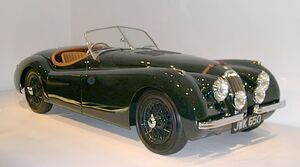
1935 Auburn Speedster advertisement

1950 Jaguar XK120 Roadster
A roadster is a two-seat car, without a fixed roof and with emphasis on sporty handling. While roadsters usually have soft-tops, retractable hard-tops are becoming more common.
History[]

1932 Duesenberg J Murphy-bodied roadster
Traditionally, roadster bodies were widely available, spanning the gamut from a Ford Model T to a Cadillac V-16. They are popular with collectors, often valued higher than even other open styles.[citation (source) needed]
Hot rod roadsters[]
The American hot rod is largely based on pre-World War II roadsters and coupes. Late run Model Ts and 1932 Fords are the most popular starting points.
Championship race cars[]

Ferrari 375 Indy front-engined roadster that raced in the 1952 Indianapolis 500.
The term roadster was also applied to front-engined AAA/USAC Championship Cars, primarily associated with the Indianapolis 500. Roadsters are cars with the engine and drive shaft offset from the centerline of the car. This allows the driver to be seated lower in the chassis and facilitates weight offset which is beneficial on the oval tracks. Frank Kurtis built the first roadster for the 1952 Indianapolis 500 and it was driven by Bill Vukovich who led most of the race until a steering failure eliminated him late in the race. The team went on to win the 1953 and 1954 contests with the same car. A. J. Watson and Quinn Epperly were other notable Roadster constructors. Roadsters disappeared from competition by the end of the 1960s, after the introduction, and subsequent domination, of rear-engined machines. The final roadster to make the race was built and driven by Jim Hurtubise in the 1968 race and dropped out early. Hurtubise attempted to run the same car in 1969 but while making his qualifying run at a very good speed the engine failed on the last of the four laps. The car was entered many times after that but was never seriously considered fast enough to start. Some pavement midgets were built and race into the early 1970's but never were dominant.
In the strictest sense the term "Roadster" when applied to racing cars indicated a car where the drivers seat was beside the drive shaft, instead of over the drive shaft on the chassis centerline as it had been the custom on earlier single seat cars.
The term originated with hot rods built from production cars which were popular in California racing following World War 2. The commonly believed story is that a team was preparing a new car for Indianapolis and had it covered in a corner of their shop. If they were asked about their car they would try and obscure its importance by saying that it was just their (hot rod) "roadster". After the Indianapolis racer was made public the "roadster" name was still attached to it.
See also[]
- Barchetta, a related two-seater body style designed primarily for racing
- Convertible, the general term to describe vehicles with retractable roofs
- Globe Four, an early American Roadster manufacturer
- Hot rod
- Roadster utility
- Tonneau, a protective cover for the seats in an open car.
References[]
| This article does not cite any references or sources. Please help improve this article by adding citations to reliable sources. Unverifiable material may be challenged and removed. (May 2010) |
External links[]
| This page uses some content from Wikipedia. The original article was at Roadster. The list of authors can be seen in the page history. As with Tractor & Construction Plant Wiki, the text of Wikipedia is available under the Creative Commons by Attribution License and/or GNU Free Documentation License. Please check page history for when the original article was copied to Wikia |